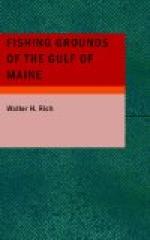The depths here are from 70 to 100 fathoms over a broken bottom of mud, gravel, and in places fine sand. The ground falls off rapidly on all sides except toward Seal Island and the Nova Scotia coast, leaving an area at its end of somewhat indeterminate length, perhaps 18 or 20, miles, and having a distance across of about 8 miles at its widest part.
Apparently there is no reason why this should not be an all-the-year fishing ground, but it seems not to be visited much in the winter. It furnishes, however, a very good summer handline fishery for cod at dogfish time, and in the spring months it abounds in cod, cusk, and hake, all fish of large size.
Roseway Bank. This bank lies N. of the western part of La Have and Se. of Shelbourne Light, Nova Scotia: 31 miles SSE. from the whistling buoy off Lockport, Nova Scotia, to the southeastern edge. It is oblong in shape and of small extent—about 270 square geographical miles. Its greatest length is 21 miles and its greatest breadth 15 miles. It extends from 43 deg. 12’ to 43 deg. 33’ north latitude, and from 64 deg. 25’ to 64 deg. 52’ west longitude and at the northwest corner is connected with the shore limit of 60 fathoms by a narrow neck. Depths are from 33 to 48 fathoms. The bottom is of sand, gravel, and rocks; on the Northeast Peak the bottom is of yellow mud and gravel.
Currents in this region are not nearly so strong as about Cape Sable and Browns Bank, their general direction being WSW. and ENE the westerly much the stronger, though the force and direction of both are much influenced by the winds.
The principal fish taken here are cod, haddock, and cusk, but hake, pollock and halibut occur, the best fishing months being from May to October, when the bank is resorted to by craft from western Nova Scotia. A few New England craft also fish here.
La Have Bank. Situated eastward of Browns Bank and S. and E. of Roseway Bank. It extends from 42 deg. 34’ to 43 deg. 26’ north latitude a distance of 52 miles, and from 63 deg. 50’ to 65 deg. 07’ west longitude a distance of about 54 miles. The bank is nearly divided into two portions, of which the eastern (La Have Bank proper) extends N and S. 39 miles and the western portion nearly E. and W. about 35 miles. The total area of the bank is about 1,200 miles.
The bottom is largely coarse gravel, pebbles, and rock, with smaller areas of sand distributed here and there. Depths run from 40 to 50 fathoms. The general set of the currents is to the westward, but this is much influenced by the force and direction of the wind and is generally quite strong during easterly blows.
The principal fishing upon this bank in the past has been for cod and haddock: and while former reports, (1881) speak of this as having once been a favorite fishing ground for halibut and state that it was not at time of much importance in that fishery, the figures for this ground for the year 1923 show the halibut catch to have been third in volume and first in value of the species taken there. In fact, the catch of halibut here makes quite an imposing figure when the comparatively small size of the ground is considered.




